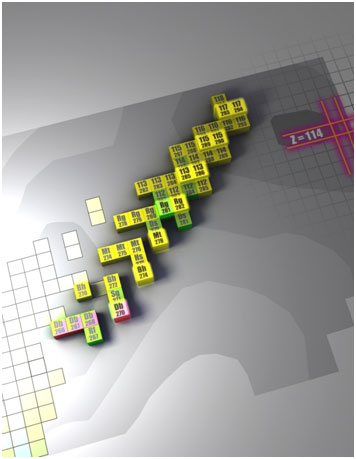
22 mg 249Bk after chemical separation in the bottom of a centrifuge cone (green solution). The 252Cf contamination was reduced about 108 times during the purification process at the Radiochemical Engineering Development Center at ORNL.
The newest element with an atomic number Z=117 created in a Russian accelerator laboratory in Dubna required coordinated collaborative efforts between four institutions in the US and two in Russia and more than two years to achieve, highlighting what true international cooperation can accomplish. The identification of element 117 among the products of the
249Bk
+48Ca reaction occurred in late 2009 and was published in April, 2010 (
Phys. Rev. Lett. 104 (2010) 142502). Production of the
249Bk target material, with a short half-life of T
1/2=320 days, required an intense neutron irradiation at ORNL’s High Flux Isotope Reactor (HFIR), chemical separation at ORNL from other reactor produced products including
252Cf, followed by target fabrication in Dimitrovgrad, Russia and six months accelerator bombardment with an intense
48Ca beam at Dubna, Russia—a continual race against radioactive decay. Analysis of the experimental data was performed independently at Dubna and LLNL, providing nearly round-the-clock data analysis due to the 11-12 hour time difference between Russia and California. Six atoms of element 117, five of
293117 and one of
294117, were observed during the course of the accelerator experiment and in total eleven new nuclides were discovered in the decay products of those two new Z=117 isotopes. The measured half-lives of new super heavy nuclei were observed to increase with larger neutron number. It represents an experimental verification for the existence of the predicted island of enhanced stability. Vanderbilt and UNVL scientists and students also contributed to this successful experiment.

Upper end of the chart of nuclides highlighting the eleven new nuclides produced in this work as a result of synthesizing 293117 and 294117.


